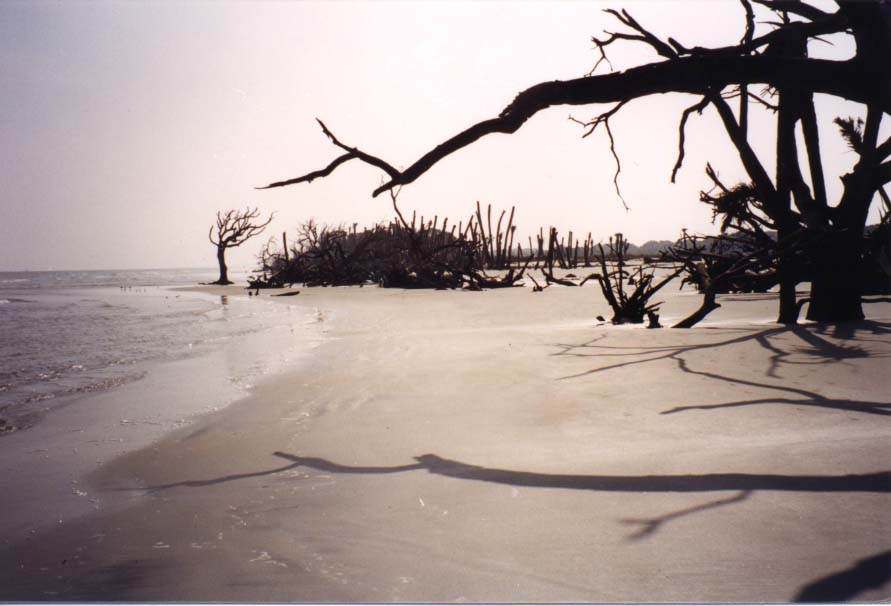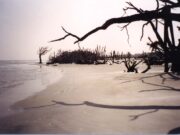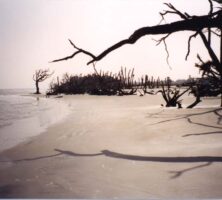The Guale (pronounced “wally”) Indians of coastal Georgia were among the first indigenous peoples met by Europeans exploring north of Mexico. Beginning in the 1560s, the Guale were exposed to a long, intensive period of Spanish mission activity. Because the Spanish colonists were few in number, they employed the missions as an agency to occupy, hold, and settle the Georgian frontier.

Photograph by Jason D. Williams
Mission Santa Catalina de Guale was established on St. Catherines Island off the Georgia coast sometime in the early 1590s. It was the northernmost base of the Spanish colony of La Florida. It survived until 1680, when Captain Francisco de Fuentes rallied his Spanish soldiers and Guale musketeers in a failed effort to protect the mission from attack by English raiders from Charleston, South Carolina. The fall and abandonment of Mission Santa Catalina signaled the waning of Spanish control in the American Southeast and set the stage for British domination of the American colonies.
Seeking Santa Catalina
In 1680 Santa Catalina de Guale was a mission abandoned and, within a few decades, became a mission lost. For the next 300 years antiquarians, historians, and archaeologists speculated about the whereabouts of the mission. The combined French, English, and Spanish historical documentation available in the late 1970s supplied little more than general geographic clues.
In 1977 the Edward John Noble Foundation, which owned St. Catherines Island, requested that the American Museum of Natural History attempt to find the site of Mission Santa Catalina. After a four-year program of field reconnaissance—combining randomized transect surveys with geophysical prospection—the archaeological team successfully located the long-lost Franciscan mission on St. Catherines Island in 1981.
Excavation of the Site
The American Museum of Natural History excavated the site for fifteen years, and most of the archaeological evidence is from the seventeenth-century settlement. The entire mission complex and the Guale pueblo that surrounded it followed a rigid grid system, with the long axis of the church oriented 45 degrees west of magnetic north. The central plaza was rectangular, with the church defining the western margin of the central plaza; the cocina (kitchen) and convento (monastery or living quarters) fringed the eastern margin.
Two churches, or iglesias, at Santa Catalina were exposed during the American Museum excavations. The late-sixteenth-century iglesia was destroyed by fire, probably in September 1597. After a period of abandonment, the mission church was reconstructed in 1604 on a single nave plan (lacking both transept and chancel). The sanctuary end of the church, constructed entirely of wooden planking, was apparently elevated above the lateral wattle-and-daub walls of the nave. A clearly demarcated sacristy contained a cache of charred wheat, which was probably destined to be baked into the “host,” the flatbread used in the Eucharist. Although wheat never assumed great dietary importance to Spaniards living in La Florida, this cache underscores the effectiveness of the Franciscan Order in obtaining the supplies necessary for the proper conduct of Catholic Church ritual—even on the most remote northern frontier of the Guale province.
The only known campo santo (cemetery) at Santa Catalina was found inside the church, where at least 431 individuals were buried beneath the floor. The campo santo also contained an astounding array of associated grave goods, including nearly three dozen crosses, Franciscan medallions, small medals, so-called Jesuit finger rings (with unique sculpted Sacred Heart castings), a cast figurine of the infant Jesus, and many other religious and utilitarian items. The cemetery also contained 70,000 glass trade beads sewn onto clothing and sashes as well as made into jewelry and ornaments, plus a number of partial rosaries.
Across the plaza to the east stood the convento and cocina complex. The convento comprised one or more subsidiary buildings in which friars and lay brothers lived cloistered lives according to the rules of their Franciscan Order. The earlier convento was probably built in the early 1590s, shortly after the Franciscans arrived. The kitchen and refectory were probably housed inside the sixteenth-century convento, and the other rooms were probably used for living quarters and storage. This building was probably burned by rebellious Guale in the fall of 1597. When Friar Pedro Ruíz supervised the reconstruction in 1604, he separated sacred from secular, erecting a detached kitchen to the north of the new convento.
Immediately outside the back of the convento was a concentration of nearly four dozen bronze bell fragments (other fragments have been found haphazardly scattered about Santa Catalina). Several pieces show punch and axe marks, indicating that the bells were deliberately destroyed, probably also during the 1597 uprising. Like all sacred vessels of the church, bells were consecrated and blessed, even after they were broken. The friars who returned to Santa Catalina some years later undoubtedly came upon some of these fragments, and the broken bells found may have been a deliberate cache of still-consecrated fragments, perhaps intended for recycling into new bells.
Two wells, both sources of holy water, were discovered on the eastern side of the plaza. The first, located during the magnetometer survey, was a simple barrel well, consisting of seven decomposing iron rings above the well-preserved remains of an oak casing. Sometime in the seventeenth century, the Franciscans dug a second, much larger well between the cocina and the convento. It was one of the last features built at the mission and was probably in use until the site’s abandonment.
Legacy
All of the artifacts from Mission Santa Catalina de Guale were given to the Fernbank Museum of Natural History in Atlanta, and after thorough bioarchaeological analysis, all human remains were reinterred inside the church.
The Spanish friars dispatched to frontier missions like Santa Catalina profoundly influenced the religious and social conduct within the colony of La Florida. They were the primary agents in establishing new settlements, determining the nature of defensive installations, and formulating agrarian policy. But the micos, or leaders, of Guale—the native power brokers—also exerted a huge influence, negotiating the details and nuances of daily life along the Georgia coast. Although the missions of Spanish Floridaare largely invisible today, they had a lasting effect on the cultures of its native peoples—and on the course of early colonial history.





